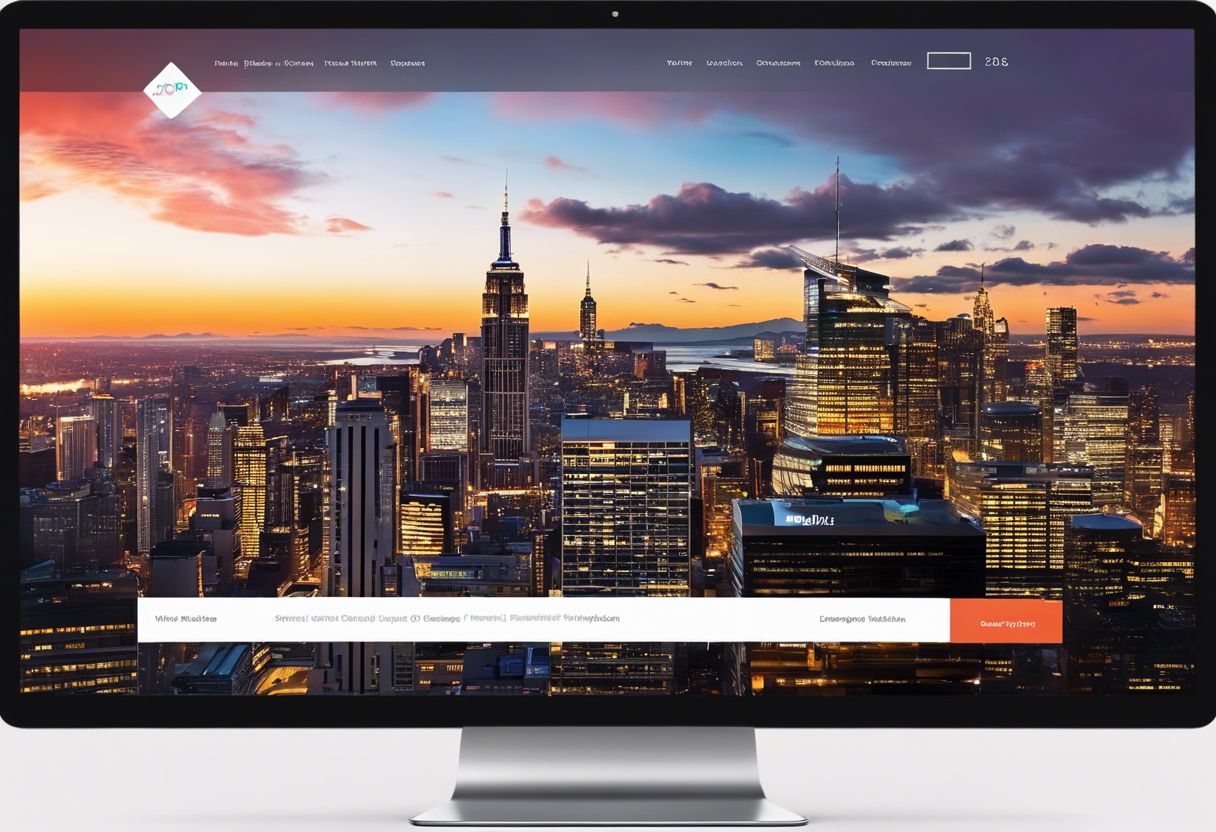Transform Your Website: Unleash The Power Of Effective CTAs

Hey there, business owners! Let’s talk about a secret power on your website that can make people do what you want. It’s called a Call to Action or CTA for short. A CTA is like a sign that tells people where to go and what to do next.
Like “Buy Now” or “Sign Up.” These little signs are super important because they help get more sales.
But hold on, it’s not just about slapping any button on your site. You’ve got to make the perfect one using words that get people moving, showing them why it’s great for them, and making them feel like they need it now.
Plus, how your button looks – its size, color, and where you put it – really matters too because our eyes follow cool designs!
And guess what? When we talk right to someone with our CTAs – I mean really talk to them personally – folks are over two times more likely to take action! We’ve also found out that if you tell someone something might run out soon; they don’t want to miss out.
There are so many places we can use these buttons – on websites, in emails, all over social media platforms and especially when we have something special just for some pages.
We’re always trying new things with our CTAs too. We test different ones against each other and see which works best; we fix up our mobile sites so everyone has an easy time clicking; and we’re constantly learning better ways to make sure those buttons shine!
All of this makes such a big difference – sometimes even making three times more people jump into action!
Ready to turn clicks into customers? Let’s learn how amazing CTAs can be for your business! Keep reading as we dive in together.
Understanding CTAs: The Gateway to Conversion

CTAs, or calls to action, are the key to converting website visitors into leads or customers. They are strategic prompts that guide users towards taking a specific action, such as making a purchase, signing up for a newsletter, or downloading a resource.
Understanding how CTAs work and their impact on conversion rates is crucial for optimizing your website’s performance.
Definition of a Call to Action

A Call to Action, or CTA for short, is like a signpost on your website that tells visitors what to do next. It’s an instruction we give them, such as ‘Buy Now’, ‘Sign Up’, or ‘Learn More’.
This little nudge helps turn people who are just looking around into real customers or followers. We put CTAs all over our websites because we want folks to move forward in their journey with us – whether that’s buying something, getting more information, or reaching out to us.
We know how powerful words can be and the right CTA phrase does wonders. It taps into visitors’ feelings and makes things feel urgent. By saying “Join today” instead of just “Join”, we create excitement and make people feel like they’re getting something special right away.
Plus, telling them about the good stuff they’ll get after clicking really works! Our goal with every CTA is to make it clear and enticing so that visitors can’t resist clicking through.
Think of each CTA as a helpful friend guiding website guests towards cool places they’ll love – whether it’s checking out new products or signing up for an amazing newsletter. We pack each one with a ton of persuasion power because these little buttons play a huge role in boosting our conversion rates – turning casual browsers into valued participants in our brand’s story.
The Role of CTAs in Conversion Rates

Now that we’ve talked about what a call to action is, let’s see how they help you get more people doing what you want on your site. CTAs are like signposts on your website; they guide visitors and tell them what to do next.
Having clear and bold CTAs can really push up your conversion rates. It’s simple: if folks know exactly where to click, there’s a better chance they’ll make a purchase, sign up, or do another important action.
We use CTAs as friendly nudges for users to take the leap. For example, changing where we place our button can make more people act. When we track how many clicks and conversions each CTA gets, it shows us which ones work best.
Let’s say only about 2 out of 100 people do what we want them to on average; with killer CTAs, we could boost those numbers much higher.
Our goal is always getting users excited and ready to click through without hesitation! We create urgency by using words like “now” or “limited time offer.” This makes visitors feel like they should act fast before missing out.
Plus, letting them know clearly what value they’ll get after clicking – whether it’s free shipping or an instant download – often seals the deal. So every time someone lands on our page, our CTAs are there working hard behind the scenes making sure that visit counts!
Crafting the Perfect CTA

Crafting the perfect CTA involves using action-oriented language to prompt immediate engagement from your audience. Highlighting the value proposition and creating a sense of urgency and anticipation can significantly increase the effectiveness of your CTAs.
Using Action-Oriented Language

We know our words have power, especially on our websites. For a Call to Action (CTA) that grabs attention, we use action-oriented language. This kind of writing pushes people to act now.
Think about phrases like “Grab your free trial” or “Join us today”. These are short and strong commands that get folks moving.
Action words make CTAs pop. We choose verbs loaded with energy and promise results—verbs like discover, build, learn, or start can fire up people’s emotions. That emotional spark often turns into clicks and conversions because it feels personal and urgent.
Next up is figuring out how to show off the great stuff you offer with your CTA..
Highlighting Value Proposition

Crafting the perfect call to action entails highlighting the value proposition in a compelling message that emotionally connects with our audience. By using persuasive language and an enticing promise of discovery, we can encourage engagement and entice users to take action.
It’s crucial to clearly communicate the benefits or value proposition of following the CTA, as this increases the likelihood of audience connection and prompts them to act. Emphasizing how engaging with the CTA will lead to gaining knowledge or discovering something new enhances its appeal and encourages higher levels of conversion.
When it comes to crafting effective CTAs, understanding how to highlight their value proposition is key in encouraging audience engagement while enticing them towards action. Now let’s delve into the design elements that support these essential aspects of creating successful call-to-action strategies.
Creating Urgency and Anticipation

Crafting the perfect CTA involves infusing it with a sense of urgency and anticipation. By using timing words, such as “now” or “limited time offer,” in the CTA copy, you can create a feeling of urgency that motivates users to act quickly.
This tactic has been shown to significantly increase click-through rates and drive conversions. Additionally, incorporating scarcity into your CTAs by highlighting limited quantities or exclusive opportunities can also boost conversions by up to 332%.
These psychological tactics harness inherent human behavior and entice users to engage with your call to action.
Furthermore, personalized CTAs tailored to different user personas outperform basic CTAs by 202%, indicating the importance of crafting CTAs that resonate with individual needs and preferences.
By leveraging these strategies, we can optimize our CTAs for maximum engagement and conversion rates on our website.
Design Elements of Effective CTAs

Button design and placement, the role of colors and fonts, and incorporating CTAs into overall website design are critical factors in creating effective calls to action. These elements play a crucial role in catching the user’s attention and compelling them to take action.
Button Design and Placement

When it comes to button design and placement, it’s important to pay attention to crucial details. The size of the CTA button matters less than its color and copy. Color psychology plays a significant role in influencing user action on a website.
Therefore, the choice of color for your CTA buttons should be strategic, keeping in mind the emotional impact different colors can have on users’ behavior. Additionally, strategic placement of CTAs within your website’s layout can enhance user engagement and conversion rates.
Incorporating effective CTAs into your website through thoughtful button design and strategic placement is essential for driving user interaction and ultimately boosting conversion rates.
The Role of Colors and Fonts

When it comes to crafting effective CTAs, the role of colors and fonts cannot be overstated. The color scheme chosen for a website can trigger different responses and perceptions about a business.
It’s vital to ensure that the design elements, such as attention-grabbing contrasting colors and strategically chosen fonts, draw the reader’s eye to the CTA button. Colors evoke emotions and can influence people’s actions; red, for instance, is often associated with urgency or importance.
Consistency in design is paramount when incorporating colors and fonts into CTAs. Best practices include maintaining consistency in color, font, aesthetic style, and tone while ensuring distinctiveness from other website elements.
Color plays a significant role in influencing human behavior and emotions. Therefore, understanding how different hues affect consumer response can have a profound impact on driving action through CTAs.
Incorporating CTAs into Overall Website Design

When incorporating CTAs into overall website design, it is crucial to pay attention to button design and placement. Use contrasting colors for the buttons so they stand out and are easy to find.
Also, consider the font size and style for the text on the buttons – it should be clear and readable. Ensure that CTAs are strategically placed throughout the website, especially on key landing pages or high-traffic areas.
In addition, make sure that your CTA aligns with the user experience of your website. It should seamlessly fit into the overall layout and not disrupt navigation. The goal is to make it easy for visitors to take action without feeling overwhelmed or confused by a cluttered design.
Types of CTAs and Where to Use Them

Web page buttons, email campaign CTAs, social media prompts, and landing page exclusives are just a few of the types of CTAs that can significantly impact your website’s conversion rates.
Each type has its own unique strategy for implementation to maximize effectiveness. Ready to dive deeper into these strategies? Keep reading!
Web Page Buttons

We know that web page buttons play a crucial role in guiding visitors towards specific actions. Here, we outline the different aspects of web page buttons and how they can be effectively utilized to boost user engagement and drive conversions.
- Clear and Action-Oriented Language: Use concise and compelling phrases that prompt visitors to take immediate action, such as “Get Started,” “Download Now,” or “Learn More.”
- Placement for Visibility: Position the web page buttons strategically within the layout to ensure they are easily noticeable without overshadowing other essential content.
- Consistent Color Scheme: Maintain a consistent color scheme that aligns with your brand identity, while also considering the psychological impact of colors on user behavior.
- Size and Design: Opt for button sizes that are proportionate to their importance, ensuring they stand out while complementing the overall design aesthetic of the website.
- Mobile Responsiveness: Ensure that web page buttons are optimized for mobile devices, allowing for seamless interaction across various screen sizes.
- A/B Testing: Implement A/B testing to assess the performance of different button designs, placements, and messaging to determine the most effective combination for driving conversions.
- Integration with Value Propositions: Align web page buttons with specific value propositions or offerings to clearly convey the benefits of taking action.
- Engagement Tracking: Utilize analytics tools to track user interactions with web page buttons and gain insights into visitor behavior and preferences.
- Providing Incentives: Consider offering incentives or rewards tied to specific button actions to motivate users towards conversion.
- Adaptation for Specific Goals: Tailor web page buttons according to the specific goals of each page or section, catering to varied conversion objectives throughout the website.
Email Campaign CTAs

Now let’s delve into the realm of Email Campaign CTAs, which are an essential part of your marketing strategy. Here’s how you can optimize your email marketing efforts to engage your audience and boost conversion rates:
- Personalization Is Key: Tailor your CTAs to match the content of each email, making them more relevant and compelling for your audience.
- Clear and Concise Language: Use action-oriented language that clearly communicates what you want the reader to do. For example, “Shop Now,” “Learn More,” or “Get Started”.
- Strategic Placement: Position your CTAs prominently within your email, ensuring they are easily noticeable without overwhelming the recipient.
- Visual Appeal: Incorporate eye-catching design elements such as contrasting colors and compelling graphics to draw attention to your CTAs.
- A/B Testing: Experiment with different CTA variations to identify which ones resonate best with your audience, driving higher click-through rates.
- Compelling Value Proposition: Clearly communicate the benefits or incentives associated with clicking on the CTA, entailing a clear value proposition for the reader.
Social Media Prompts

Social media CTAs prompt followers to take specific actions, such as liking, sharing, or commenting on posts.
- Encourage Audience Interaction: Use CTAs in social media posts to prompt audience interaction, leading to increased engagement and brand promotion.
- Drive Website Traffic: Incorporate CTAs into social media content to direct users to your website, guiding them towards further interaction and potential conversions.
- Boost Brand Visibility: Leverage CTAs to encourage user interaction on social media platforms, increasing the visibility of your brand among your target audience.
- Prompting Behavior: Effective CTAs can prompt behavior from social media users, encouraging them to take specific actions that benefit your business.
- Enhanced User Engagement: When strategically placed within social media content, CTAs can enhance user engagement and foster a sense of community around your brand.
Landing Page Exclusives
Crafting enticing and exclusive CTAs for your landing page is crucial in driving conversions. Consider these essential Landing Page Exclusives:
- Compelling Headline: Grab attention with a catchy and clear headline that aligns with your CTA.
- Captivating Images: Use high-quality, relevant images to complement your CTA and create visual appeal.
- Persuasive Copy: Create compelling content that emphasizes the benefits of clicking the CTA.
- Limited-Time Offers: Utilize scarcity or time-sensitive offers to prompt immediate action.
- Trust Indicators: Display trust badges or customer testimonials to instill confidence in clicking the CTA.
- Clear Direction: Ensure the CTA’s purpose is unmistakable and guides visitors on the next step.
Optimizing Your CTAs

Optimizing your CTAs is crucial for improving conversion rates and user engagement. A/B testing, mobile optimization, and website optimization techniques are essential for maximizing the performance of your call to actions.
A/B Testing for Performance
As business owners, we understand the importance of making data-driven decisions to continuously improve our website’s performance. A/B testing is a crucial tool for website optimization, allowing us to delve into the minds of our customers and uncover their preferences and motivations.
With A/B testing, we can experiment with different call-to-action (CTA) copies, placement, size, and color schemes to determine the most effective approach for increasing sales, leads, and website traffic.
By comparing two versions of a marketing asset based on changing one element – such as CTA text or image on a landing page – we can focus on experimenting with different creative elements, copy layouts, and algorithms to improve key business metrics.
We need to track specific A/B testing metrics and key performance indicators (KPIs) in order to ensure that our efforts are yielding positive results. By optimizing our CTAs through A/B testing strategies aligned with customer behavior insights and mobile-specific optimizations, we can boost conversion rates while maximizing lead generation potential.
Real-world examples showcasing the effectiveness of A/B testing further emphasize its significance in driving measurable improvementsacross various aspects of our online presence — from click-through rates to overall sales figures.
Mobile Optimization Strategies
Optimizing your website for mobile devices is crucial. Here are the strategies you need to implement:


